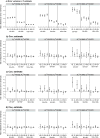Relationship between Roe and Metz simulation model for multireader diagnostic data and Obuchowski-Rockette model parameters
- PMID: 29609206
- PMCID: PMC5980727
- DOI: 10.1002/sim.7616
Relationship between Roe and Metz simulation model for multireader diagnostic data and Obuchowski-Rockette model parameters
Abstract
For the typical diagnostic radiology study design, each case (ie, patient) undergoes several diagnostic tests (or modalities) and the resulting images are interpreted by several readers. Often, each reader is asked to assign a confidence-of-disease rating to each case for each test, and the diagnostic tests are compared with respect to reader-performance outcomes that are functions of the reader receiver operating characteristic (ROC) curves, such as the area under the ROC curve. These reader-performance outcomes are frequently analyzed using the Obuchowski and Rockette method, which allows conclusions to generalize to both the reader and case populations. The simulation model proposed by Roe and Metz (RM) in 1997 emulates confidence-of-disease data collected from such studies and has been an important tool for empirically evaluating various reader-performance analysis methods. However, because the RM model parameters are expressed in terms of a continuous decision variable rather than in terms of reader-performance outcomes, it has not been possible to evaluate the realism of the RM model. I derive the relationships between the RM and Obuchowski-Rockette model parameters for the empirical area under the ROC curve reader-performance outcome. These relationships make it possible to evaluate the realism of the RM parameter models and to assess the performance of Obuchowski-Rockette parameter estimates. An example illustrates the application of the relationships for assessing the performance of a proposed upper one-sided confidence bound for the Obuchowski-Rockette test-by-reader variance component, which is useful for sample size estimation.
Keywords: Obuchowski-Rockette; Roe and Metz model; diagnostic radiology; receiver operating characteristic (ROC) curve.
Copyright © 2018 John Wiley & Sons, Ltd.
Figures





Similar articles
-
Roe and Metz identical-test simulation model for validating multi-reader methods of analysis for comparing different radiologic imaging modalities.J Med Imaging (Bellingham). 2023 Feb;10(Suppl 1):S11916. doi: 10.1117/1.JMI.10.S1.S11916. Epub 2023 Jul 5. J Med Imaging (Bellingham). 2023. PMID: 37416057 Free PMC article.
-
Determining Roe and Metz model parameters for simulating multireader multicase confidence-of-disease rating data based on real-data or conjectured Obuchowski-Rockette parameter estimates.J Med Imaging (Bellingham). 2022 Jul;9(4):045501. doi: 10.1117/1.JMI.9.4.045501. Epub 2022 Jul 8. J Med Imaging (Bellingham). 2022. PMID: 35818569 Free PMC article.
-
Determining Roe and Metz model parameters for simulating multireader multicase confidence-of-disease rating data based on real-data or conjectured Obuchowski-Rockette parameter estimates.Proc SPIE Int Soc Opt Eng. 2020 Feb;11316:113160N. doi: 10.1117/12.2550541. Epub 2020 Mar 17. Proc SPIE Int Soc Opt Eng. 2020. PMID: 32317812 Free PMC article.
-
The value of observer performance studies in dose optimization: a focus on free-response receiver operating characteristic methods.J Nucl Med Technol. 2013 Jun;41(2):57-64. doi: 10.2967/jnmt.112.116566. Epub 2013 Apr 26. J Nucl Med Technol. 2013. PMID: 23625536 Review.
-
Assessment of medical imaging systems and computer aids: a tutorial review.Acad Radiol. 2007 Jun;14(6):723-48. doi: 10.1016/j.acra.2007.03.001. Acad Radiol. 2007. PMID: 17502262 Review.
Cited by
-
Identical-test Roe and Metz simulation model for validating multi-reader methods of analysis for comparing different radiologic imaging modalities.Proc SPIE Int Soc Opt Eng. 2022 Feb-Mar;12035:120350E. doi: 10.1117/12.2612691. Epub 2022 Apr 4. Proc SPIE Int Soc Opt Eng. 2022. PMID: 36159879 Free PMC article.
-
Roe and Metz identical-test simulation model for validating multi-reader methods of analysis for comparing different radiologic imaging modalities.J Med Imaging (Bellingham). 2023 Feb;10(Suppl 1):S11916. doi: 10.1117/1.JMI.10.S1.S11916. Epub 2023 Jul 5. J Med Imaging (Bellingham). 2023. PMID: 37416057 Free PMC article.
-
Determining Roe and Metz model parameters for simulating multireader multicase confidence-of-disease rating data based on real-data or conjectured Obuchowski-Rockette parameter estimates.J Med Imaging (Bellingham). 2022 Jul;9(4):045501. doi: 10.1117/1.JMI.9.4.045501. Epub 2022 Jul 8. J Med Imaging (Bellingham). 2022. PMID: 35818569 Free PMC article.
-
Paired split-plot designs of multireader multicase studies.J Med Imaging (Bellingham). 2018 Jul;5(3):031410. doi: 10.1117/1.JMI.5.3.031410. Epub 2018 May 17. J Med Imaging (Bellingham). 2018. PMID: 29795776 Free PMC article.
-
Implementing multiple imputations for addressing missing data in multireader multicase design studies.BMC Med Res Methodol. 2024 Sep 27;24(1):217. doi: 10.1186/s12874-024-02321-3. BMC Med Res Methodol. 2024. PMID: 39333923 Free PMC article.
References
-
- Dorfman DD, Berbaum KS, Lenth RV, Chen YF, Donaghy BA. Monte Carlo validation of a multireader method for receiver operating characteristic discrete rating data: factorial experimental design. Academic Radiology. 1998;5:591–602. - PubMed
-
- Beiden SV, Wagner RF, Campbell G. Components-of-variance models and multiple-bootstrap experiments: An alternative method for random-effects, receiver operating characteristic analysis. Academic Radiology. 2000;7(5):341–9. - PubMed
-
- Beiden SV, Wagner RF, Campbell G, Chan HP. Analysis of uncertainties in estimates of components of variance in multivariate ROC analysis. Academic Radiology. 2001;8(7):616–22. - PubMed
-
- Wagner RF, Beiden SV, Metz CE. Continuous versus categorical data for ROC analysis: some quantitative considerations. Academic Radiology. 2001;8(4):328–34. - PubMed
Publication types
MeSH terms
Grants and funding
LinkOut - more resources
Full Text Sources
Other Literature Sources
Molecular Biology Databases
